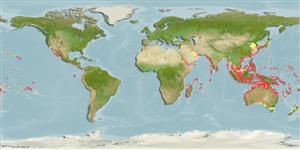Common names from other countries
Environment: milieu / climate zone / depth range / distribution range
Ecologia
; intervalo de profundidade 0 - 65 m (Ref. 101209). Tropical
Indo-Pacific.
Length at first maturity / Tamanho / Peso / Idade
Maturity: Lm ? range ? - ? cm Max length : 9.5 cm SHL macho/indeterminado; (Ref. 349); common length : 4.0 cm SHL macho/indeterminado; (Ref. 349)
The common species is collected for food by coastal people in many parts of the area (Ref. 349). Inhabits rocky and coral-rock bottoms, or on stones and larger shells. Also found in shallow subtidal zones (Ref. 349). Members of the family Patellidae graze on encrusting lichens and algae, or scrape tissue from kelp (Ref. 349).
Life cycle and mating behavior
Maturidade | Reprodução | Desova | Ovos | Fecundidade | Larvas
Members of the order Archaeogastropoda are mostly gonochoric and broadcast spawners. Life cycle: Embryos develop into planktonic trocophore larvae and later into juvenile veligers before becoming fully grown adults.
Poutiers, J.M. 1998. (Ref. 349)
Categoria na Lista Vermelha da IUCN (Ref. 130435)
Categoria CITES (Ref. 108899)
Not Evaluated
Not Evaluated
Ameaça para o homem
Harmless
Utilização humana
| FishSource |
Ferramentas
Mais informação
Idade/Tamanho
Crescimento
Comprimento-peso
Comprimento-comprimento
Morfologia
Larvas
Abundância
Fontes da internet
Estimates based on models
Preferred temperature
(Ref.
115969): 22.3 - 29, mean 27.8 (based on 1014 cells).
Vulnerabilidade
Low vulnerability (10 of 100).
